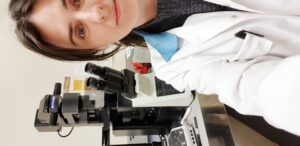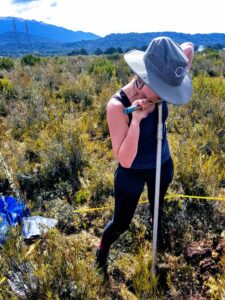By Dr Annie Lau
I got the opportunity to ask Dr Michelle McKeown some questions before she moves out of Australasia and back to her native country, Ireland. I wish her all the best in her new role as a lecturer at University College Cork!
1. Hi Michelle, you seem to have worked in many countries. Please tell us about yourself and your career path!

I am very fortunate to have had the opportunity to work in Ireland, Fiji and New Zealand. I am a palaeoecologist/palaeoclimatologist and I primarily use biological indicators to reconstruct climate and environmental conditions over the Holocene. I studied Geography at the National University of Ireland Galway (NUIGalway) from 2005 to 2008. I started my PhD in 2009 with the Paleoenvironmental Research Unit in NUIGalway. My project explored the sensitivity of chironomids (non-biting midges) to fluctuations in summer air temperature. This research further developed chironomids as a palaeoclimate tool for reconstructing temperature through the Holocene in an Irish context. When I graduated in 2014, I started a lectureship in The University of the South Pacific. I spent three years in Fiji, working on numerous projects from archaeology to paleoenvironmental reconstruction. I decided to move to New Zealand in 2017 and took up a research position in Manaaki Whenua Landcare Research. Here, my research focused on furthering our understanding of testate amoebae (shelled protozoa) and their ecological shifts resulting from anthropogenic drainage in New Zealand wetlands. In 2020, I decided to join the consultancy Wallbridge Gilbert Aztec (WGA) to work on projects with a more applied component. I recently accepted a Lectureship in University College Cork so I will be leaving New Zealand soon to return to the emerald isle. But! I have funding for a palaeoclimate project in Wallis and Futuna… so I’ll be back in the Southern Hemisphere soon!
2. What drove you into palaeoecology?
I was fascinated by climate science and understanding how the climate has changed. I actually started a research masters exploring trends in a long-term historical instrumental record. One year into the project, I got to know the staff in the Palaeoenvironmental Research Unit in NUI Galway and was fascinated by the work going on in their lab. I decided to upgrade to a PhD project to have a palaeoclimate component and never looked back. I get to study sub-fossils and look for clues hidden in the earth to understand the past. It’s just an incredible research area to be in and I’m glad I made the change.
3. Answer in 3 seconds…Chironomid or testate amoebae? Why?
They are both incredible proxies! I can’t decide which one I prefer to use. I suppose it depends on the questions I’m trying to answer. Chironomids can be used to reconstruct past temperature fluctuations and changes in lake quality. Testate amoebae can be used to reconstruct past hydrological conditions and have many different applications from forensic science to understanding dispersal mechanisms. I will continue working with both proxies!
4. (Um…you avoided picking a favourite, fair enough 🙂 Moving on…) How similar or different is working in consulting vs academia?
The main similarity is working on environmental issues and carrying out project-based work. There are some definite differences between life in a consulting world and that of academia. One of the main differences is the extent to which you can influence the focus of your projects. In my opinion, the main advantage of consultancy is that the applicability of your work is more evident. One of the main disadvantages is that you are bound to solely address the questions of your client, as they are paying you to provide a solution to their environmental issue. You must be very time efficient in a consulting environment. You provide a cost for the anticipated time it will take you to complete a project and if you go over the budget, your company makes a loss. The problems you address are not simple and you rarely have the time or budget to answer them to the same degree that an academic publication requires. This has been the biggest adjustment for me. However, you get to work on a broad range of projects, and this can be excellent for broadening your knowledge on environmental issues. For example, I know a lot more about hydrology and hydrogeology since working at WGA. My favourite aspect of consulting was working with engineers, hydrologists and hydrogeologists and being able to contribute positively to the ecological aspect of projects.
5. What would you tell ECRs who are considering a career outside of academia?
I would suggest getting as many broad practical skills as you can while in academia. I found that my statistical skills and ability to code in R has been incredibly sought after. For anyone working at a university, helping in labs and field exercises in subjects outside your research area is a great way to develop a broader skillset. I was a teaching assistant for a hydrology and geomorphology course (while I was a PhD student) and these skills have been incredibly useful working as a consultant. Also getting to know the staff at regional councils is important as you will be working closely with them.
6. What are your passions outside of science and research?
I am passionate about travelling and challenging myself with new experiences. It’s a great way to learn new things and immerse yourself in a culture that’s different to your own. Any opportunity I get to travel I take it. I’ve been very fortunate to have this privilege and I suppose being an academic and consultant means that travel is part of the job. I also love reading and painting, which were great lockdown activities!
